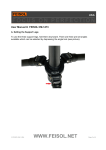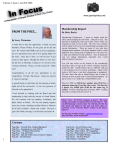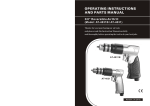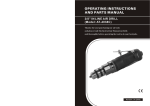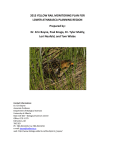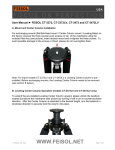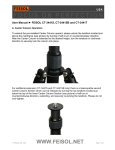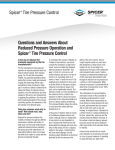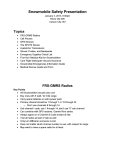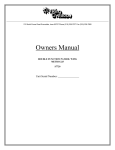Download Field Guide to Working Safely on Ice Covers
Transcript
14 13 12 11 10 FIELD GUIDE to Working Safely on Ice Covers 9 8 7 6 5 4 3 2 1 1 Plan Ice Cover Limits Emergency Ice covers can be dangerous. Not knowing what to watch out for can kill you. How to use this guide This guide is for people who work on freshwater floating ice covers. It is based on the Government of Alberta’s Best Practice for Building and Working Safely on Ice Covers in Alberta. Use it to support what you learn in: • your employer’s safety orientation and ice cover training No orientation? No work! • your employer’s Ice Safety Plan for this project If you don’t know the plan, you’re not ready to work. No Ice Safety Plan? No work! • your own observations Watch for cracks and other signs of stress on the ice. Published November 2009 Publication Number SH011 ISBN 978-0-7785-8738-5 © 2009 Government of Alberta If you have questions about this safety guide, please contact: Occupational Health and Safety Contact Centre Throughout Alberta: 1-866-415-8690 Edmonton and area: 780-415-8690 Deaf or hearing impaired: 1-800-232-7215 Website: www.worksafely.org 2 Plan Ice covers can be dangerous. Not knowing what to watch out for can kill you. 3 Plan Before starting work on an ice cover, know your numbers. Know your numbers Check the Ice Safety Plan for the ice thickness and maximum load and speed allowed on the ice cover. If you don’t know your numbers, don’t go on the ice! Know and watch for: • current conditions at the site: temperature, wind speed, ice thickness, areas under repair, thin ice • sudden changes in conditions: cracks, water on the ice, extreme weather changes (±20°C in 24 hours) • what to do and who to call when you need help Record your numbers Today’s temperature / wind chill °C Total weight of vehicle, cargo, fuel and people (GVW) kg Minimum ice thickness for this GVW cm Check your Ice Safety Plan for these numbers: Maximum load allowed on ice cover Maximum speed: in drive lane kg km/h near shore Minimum distance between vehicles Maximum parking time on the ice cover km/h m hrs Emergency contact numbers / radio frequency 4 You and your employer share responsibility for safety. Plan to stay safe The best tools for safe work are: • your team Your supervisor and co-workers are your safety team. Always maintain contact by radio or phone. Know and follow the call-in schedule in your employer’s working alone policy. • training and Ice Safety Plan Use this guide as a quick reference to support what you learn in your employer’s safety orientation and ice cover training programs. Know your Ice Safety Plan numbers for ice thickness, GVW limits and speed limits. • questions The only dumb question is the one you didn’t ask. If you don’t know, find out from someone who does. • safety checks Check PPE (personal protective equipment), emergency supplies and vehicle safety equipment before you start work. Check your equipment—and yourself • Check your PPE and emergency equipment. • Know your vehicle GVW and its safety equipment. • Watch for early signs of frostbite and hypothermia. 5 Eyes and ears are safety tools. Pay attention to what’s happening around you. Personal safety equipment When working on ice covers, make sure you’ve got the right equipment for the job and the conditions, check your Ice Safety Plan. Then check your PPE. Suggested PPE What you need it for • warm clothing worn in layers • to protect your face, head and neck, and maintain core body temperature • rubber-soled, felt-pack winter boots • to walk without slipping and keep your feet warm and dry • insulated waterproof gloves, mittens and overmitts • to keep your hands warm enough to work and carry out emergency tasks • sunglasses • to protect your eyes from snowblindness and glaring reflections off ice and snow • whistle • to call for help or signal others • high visibility flotation suit • to keep yourself afloat and warm in icy water • 30 metres of 10-mm thick buoyant polypropylene rope • to rescue others or be rescued if the ice fails • ice rescue picks • to grip and move along the ice to complete a self-rescue if the ice fails 6 If you don’t know the GVW, weigh the loaded vehicle. Vehicle and equipment GVW (gross vehicle weight): equipment, cargo, people—and your fully fuelled vehicle. Record the GVW and date on a sticker in the vehicle and on equipment. Safety equipment in vehicle What you need it for • axe or ice chisel, ice auger, and air temperature thermometer • measure ice thickness and air temperature • two-way radio, phone (on cellular or satellite service) or other electronic communication device • stay in contact with your team • warning devices (pylons, reflectors, flares, flags) •warn others; close danger areas • fire extinguisher •put out vehicle/equipment fires • first aid kit •treat minor injuries • metal or ceramic coffee mug •melt snow or ice for drinking • emergency rations: energy bars/ food; hot beverage mixes (instant coffee, tea, hot chocolate) •sustain energy and keep warm • snow shovel •remove snow if vehicle is stuck • sleeping bag (or blankets), backup warm clothing •keep warm and dry • candles, flashlight •see what you’re doing • waterproof matches/lighter, material to start fires •keep warm and signal others • call for help •attract attention in emergency 7 About 50 people die each year on ice over fresh water in Canada. Know what you’re doing on the ice Work on ice covers starts with recognizing hazards and knowing how to handle them. Plan your work—and your safety—with the following in mind. • what you plan to do, where, and for how long Check your Ice Safety Plan. Talk to your supervisor. • conditions and limits on the ice cover Check your Ice Safety Plan for ice thickness, speed, load and time limits. • weight of the load you plan to put on the ice cover Know your GVW. • sudden changes in temperature (±20°C in 24 hours) Check current conditions. Look at the ice. • extreme cold that affects equipment Check operator’s manuals and manufacturer’s product data sheets for minimum operating temperatures of the equipment and fluids used. • extreme cold that affects personal safety Check yourself and your team for signs of frostbite and hypothermia, which can set in gradually, before you notice them. 8 River ice can be more dangerous than lake ice because currents can erode ice and create thin spots. Setting up an ice cover (profiling) If you are the first person on the ice, you must have these safety measures in place: • an Ice Safety Plan for pre-construction and construction stages of building the ice cover that follows best practices • ice safety training that includes self-rescue techniques • a partner who knows rescue and self-rescue techniques Walking or working on foot Before you step on the ice, check your Ice Safety Plan for: • required minimum ice thickness—There must be at least 10 cm of clear, good quality ice before you can walk on it. If you plan to stand in one area for more than 2 hours, the ice cover must be at least 15 cm thick. • local conditions—Ice thickness can vary a great deal, particularly near shore, around the bend of a river, or near snowbanks. If there is open water nearby, you need specialized PPE, ice safety and rescue training. • type of work—Checking ice thickness requires working and walking in pairs. Both members of the team must wear flotation suits and remain at least 10 metres apart. They must be trained in rescue and self-rescue techniques and use the appropriate equipment for ice testing. • your team—Do not work alone when taking initial ice thickness measurements or during initial construction of ice covers. 9 On an ice road, the driving lane is the safer area. Edges are danger zones. Never drive or park on the “shoulder” or near a snowbank. Parking a vehicle or equipment Before you park a vehicle or equipment on the ice cover, check: • your GVW—Vehicle including fuel, equipment, cargo and people Check your Ice Safety Plan for: • maximum time on the ice and minimum ice thickness— For example, a light truck parked for more than 2 hours but less than 7 days requires at least 55 cm of clear, good quality ice. • variations in ice thickness—Ice is often thicker in a driving lane, but thinner and weaker near and under snowbanks beside driving lanes. • distance—Park vehicles and equipment at least 2 lengths apart—vehicle plus equipment lengths. Driving a vehicle Before driving any vehicle on the ice cover, even a snowmobile, check: • your GVW—Vehicle including fuel, equipment, cargo and people Check your Ice Safety Plan for: • ice thickness—One snowmobile needs at least 18 cm of clear, good quality ice to support GVW less than 500 kg. A light truck (GVW less than 5,000 kg) needs at least 38 cm of ice thickness. • speed limits—Always drive slower than the maximum posted speed. • minimum distance between vehicles on the same route > GVW under 5,000 kg stay 200 x ice thickness apart > heavier vehicles stay 500 x ice thickness apart • special conditions along the route—for example, areas under repair, thin ice caused by river currents, snowbanks, or near islands and shores 10 Extreme cold is hard on vehicles, equipment—and people Plan for cold weather Working on ice covers means working in cold weather. Both present risks of injury. • frostbite: Skin tissue freezes, looking white or waxy. Exposed skin is at greatest risk. • hypothermia: Body cools faster than it can generate warmth. Signs are slower pace, fatigue, lack of coordination, vigorous shivering, personality changes: Fumbles, Stumbles, Tumbles, Mumbles, Grumbles. • wet clothing: Wet clothing accelerates heat loss. Wear multiple layers and adjust them to avoid sweating, overheating. Avoid cotton—once wet, it stays wet. • windchill: Wind speed of 20 km/h can make –25°C feel as if it’s –37°C. Cold weather hazards air temperature 0°C to –20°C •at –20°C and 15 km/h wind, exposed skin is at risk of frostbite in 10–30 minutes air temperature –20°C to –45°C •increased risk of frostbite, hypothermia •outdoor travel can be dangerous •equipment failure has serious consequences air temperature colder than –45°C What to do •avoid hypothermia with warm clothing •take regular breaks to warm up •make sure equipment is in good working order at start of shift •take breaks in a warm, heated place such as a truck cab or shelter •check self and others for frostbite and hypothermia •stop all non-emergency work •serious threat to health, safety •check equipment hourly •serious risk of equipment failure •avoid skin contact with gasoline and metal objects •gasoline freezes at –56°C 11 Wind chill chart T air = air temp in ˚C V10 = wind speed at 10 m above the ground in km/h T air 5 0 -5 -10 -15 -20 -25 -30 -35 -40 -45 -50 5 4 -2 -7 -13 -19 -24 -30 -36 -41 -47 -53 -58 10 3 -3 -9 -15 -21 -27 -33 -39 -45 -51 -57 -63 15 2 -4 -11 -17 -23 -29 -35 -41 -48 -54 -60 -66 20 1 -5 -12 -18 -24 -30 -37 -43 -49 -56 -62 -68 25 1 -6 -12 -19 -25 -32 -38 -44 -51 -57 -64 -70 30 0 -6 -13 -20 -26 -33 -39 -46 -52 -59 -65 -72 35 0 -7 -14 -20 -27 -33 -40 -47 -53 -60 -66 -73 40 -1 -7 -14 -21 -27 -34 -41 -48 -54 -61 -68 -74 45 -1 -8 -15 -21 -28 -35 -42 -48 -55 -62 -69 -75 50 -1 -8 -15 -22 -29 -35 -42 -49 -56 -63 -69 -76 55 -2 -8 -15 -22 -29 -36 -43 -50 -57 -63 -70 -77 60 -2 -9 -16 -23 -30 -36 -43 -50 -57 -64 -71 -78 65 -2 -9 -16 -23 -30 -37 -44 -51 -58 -65 -72 -79 70 -2 -9 -16 -23 -30 -37 -44 -51 -58 -65 -72 -80 75 -3 -10 -17 -24 -31 -38 -45 -52 -59 -66 -73 -80 80 -3 -10 -17 -24 -31 -38 -45 -52 -60 -67 -74 -81 V10 Source: Environment Canada Low risk of frostbite for most people Frostbite guide Increasing risk of frostbite for most people in 10 to 30 minutes of exposure High risk for most people in 5 to 10 minutes of exposure High risk for most people in 2 to 5 minutes of exposure High risk for most people in 2 minutes of exposure or less 12 Ice Cover Ice covers can be dangerous. Not knowing what to watch out for can kill you. 13 Ice Cover Clear, good quality ice has uniform thickness and strength. Types of ice on an ice cover • Clear ice is relatively free of air bubbles and vegetation. • On any body of water, ice can be thinner and weaker around islands, shoals and shorelines. • Water currents, heavy snowfall, high winds and sudden changes in temperature can all affect the strength of ice. Ice type & variation in ice thickness Ice quality and strength Blue ice on lakes and rivers Freshwater lake ice (blue) • thickness varies little over an area • higher strength due to uniform thickness and quality River ice (blue) • medium to high variation in thickness • fairly uniform ice quality • more prone to losing underside ice thickness due to water currents • variable load bearing due to variable ice thickness White ice from natural or manual flooding Constructed flood ice (white) • good practices yield uniform thickness • good ice quality due to uniform thickness Natural flood or overflow ice (white) • ice thickness varies greatly • ice strength varies with variations in thickness • higher potential for water and air pockets that reduce ice thickness • variation in quality due to higher air content Ice formed over muskeg or peatland • highly variable over the entire area • surface can quickly change from frozen peat to ice floating on peat • ice cover requires special analysis (see Best Practice) • strength varies due to variations in water chemistry, temperature • frost depth depends on air temperature, peat composition, its thickness and ground cover 14 Ice types Clear blue lake ice Ice that grows below the layer of surface ice under calm conditions. It usually forms in vertical, columnar crystals that contain few air bubbles. It appears to be blue because it’s clear enough to see the water underneath it. Clear blue river ice White ice (snow ice) Ice that forms on top of the surface ice by natural or man-made flooding of snow. It’s white because it contains a significant number of air bubbles. Frazil ice (slush ice) Ice made up of disk-shaped ice particles that form and gather together in agitated water. It is usually found in rivers or streams with turbulent waters. Jam ice Accumulation of ice on rivers or streams when currents move pieces of ice to an area where they freeze together to form very rough and thick ice covers. 15 Types of ice cracks on an ice cover Type of crack & what it means What you should do Crack caused by change in temperature & ice thickness Dry cracks • do not reach bottom of ice cover • caused by ice bending due to weight of load, temperature changes • crack through ¼ to ½ ice thickness: flag area, monitor and repair, record repairs • crack through >½ ice thickness: flag and close area • report cracks to your supervisor Wet cracks • crack reaches bottom of ice cover, allowing water to reach the surface • flag and close area to others • report cracks to your supervisor Crack caused by overloading Radial cracks • look like spokes in a wheel • immediately remove load from ice • a warning that ice is overloaded—load may break through the ice • report cracks to your supervisor Circumferential cracks • form a circle around the load • immediately make sure everyone leaves the area • a warning that ice is overloaded—load is about to break through • report cracks to your supervisor EXTREME DANGER: Circumferential cracks connected with radial cracks • form pie-shaped wedges • immediately make sure everyone leaves the area • report cracks to your supervisor • ice has failed; if not already broken through, it can do so at any minute 16 Limits Ice covers can be dangerous. Not knowing what to watch out for can kill you. 17 Limits Moving vehicles stress the ice. NEVER exceed the posted speed limit. Know your limits Ice cover limits Never travel outside the boundaries of the ice cover. Travel only within the lane(s) of an ice road or bridge. Passing limits A loaded vehicle must never overtake and pass another loaded vehicle moving in the same direction. Speed limits • Posted limit is the maximum safe speed. • Slow down in bad weather, low visibility, when passing workers or meeting vehicles coming in the other direction. If speed limits are not posted, use these recommended maximum speeds. Vehicle / Ice Conditions Maximum Speed Vehicle profiling during construction 10 km/h Vehicle approaching shore 10 km/h Vehicle passing flood crews 10 km/h Load vehicles travelling in opposite directions 10 km/h Meeting oncoming vehicles 10 km/h Vehicle at minimum ice thickness for GVW 25 km/h Vehicle at 2x minimum ice thickness for GVW 35 km/h Time limits for a disabled vehicle • Move a disabled vehicle off the ice cover as soon as possible. • If you cannot remove it, move it to the driving lane where ice is thicker. • Be prepared to abandon the vehicle within the time limits stated in your Ice Safety Plan. 18 The higher the GVW, the more distance needed between vehicles. Minimum distances between vehicles • GVW up to 5,000 kg: Distance between vehicles must be at least 200 x ice thickness, e.g., on ice 1 m thick, a 4,500 kg vehicle must be 200 m distance from the next vehicle. • GVW 5,000 to 63,500 kg: Distance between vehicles must be at least 500 x ice thickness, e.g., a 10,000 kg vehicle on ice 1 m thick, must be 500 m distance from the next vehicle. • Some ice covers are on bodies of water too small to allow for the minimum distance between vehicles. In that case, there should be only one vehicle at a time on the ice cover. • If there are no markers to judge distance between vehicles, wait at least 2 minutes before you follow a light truck, if both vehicles are of similar weight and are travelling no more than 10 km/h. At 10 km/h, wait at least 5 minutes before you follow a heavy truck (up to 63,500 kg). In both cases, the ice must have the minimum thickness needed to support the GVW. 19 Minimum ice thickness for slow moving loads or loads parked less than 2 hours Use this table together with the hazard controls outlined in the Ice Safety Plan for the ice cover you are working on. Slow Moving Loads (maximum 10 km/h) Minimum Ice Thickness Person walking (120 kg) 10 cm Snowmobile: machine & rider less than 500 kg 18 cm 3/4–ton 4x4 vehicle: GVW up to 5,000 kg 38 cm Loads over 5,000 kg refer to Best Practice Minimum ice thicknesses for parked or slow moving loads less than 2 hours. For heavier vehicles, refer to the Best Practice and your Ice Safety Plan. 20 The longer a load stays in place, the greater the stress on the ice. Minimum ice thickness for loads parked for more than 2 hours and less than 7 days To know how long a load or vehicle can remain in one place on the ice, you need to know the GVW and ice thickness. Load in place more than 2 hours but less than 7 days After two hours under a load, ice begins to sag and bend, until the ice cover fails. Greater ice thickness usually means a load can be on the ice cover longer, if it’s clear, good quality ice. Load Parked or Stationary >2 hours <7 days Minimum Ice Thickness Person standing 15 cm Snowmobile: machine & rider < 500 kg 25 cm Loaded vehicle: GVW 500 to 1,000 kg 32 cm Loaded vehicle: GVW 1,000 to 2,000 kg 41 cm Loaded vehicle: GVW 2,000 to 3,000 kg 46 cm 3/4–ton 4x4 vehicle: GVW up to 5,000 kg 55 cm Loads over 5,000 kg refer to Best Practice Load in place for more than 7 days must be reviewed by a professional engineer 21 Emergency Ice covers can be dangerous. Not knowing what to watch out for can kill you. 23 Emergency Emergency procedure When something happens on the ice cover that threatens your own or someone else’s safety, work with your team to: • Stop all work in the area. • Rescue the victim if it is safe to do so. • Provide first aid and CPR as needed. • Take steps to prevent hypothermia (dry clothing, sleeping bag / blankets, sweetened hot liquids). • Call for help (air or road ambulance). • Take those in need of care to the nearest medical facility. • Clear the area / road near the incident site to allow rescue vehicles to reach the victim. • Mark and close the incident site and area with reflective pylons or flags, to warn others of potential danger. 24 Evacuation by helicopter or vehicle Serious incidents may require evacuation of the victim. • Call 911 or the nearest hospital or helicopter company. Tell the dispatcher: > Your name. Do not say the name of an injured worker over the radio. > The location of the incident > Latitude & longitude > Radio frequency to use > Number of people hurt > Type of injury(ies) > Ambulance & paramedics needed > Equipment or supplies that may be needed • Mark the incident site with brightly coloured or reflective pylons. • Evacuation by helicopter > Identify a landing area about 30 metres wide, with a clear approach such as open ground, stable ice cover or a straight section of road. Make sure the landing area is clear of debris, vehicles and equipment. > Assign someone to monitor a two-way radio on the specified frequency, to help the helicopter find the landing site. > Prepare the casualty for transport, making sure to protect the casualty from rotor wash (air movement from the helicopter’s blade). 25 The first danger is drowning, not the cold Self-rescue in freezing water If you fall through the ice, you have time to save yourself. 1 minute to control your breathing For about one minute, you’ll gasp for air, in reaction to the extreme cold. After one minute, the gasping gets less, the skin numbs and the feeling of intense cold lessens. 10 minutes to get out You have about 10 minutes to get out of the water: tread water: Don’t panic and thrash about. Resist the urge to gasp. Instead, slowly tread water or grasp the edge of the ice to keep your head above water. kick and pull: Keep your hands and arms on the ice and kick your feet. This brings your body to a horizontal position, parallel to the ice surface. horizontal kick and pull: Once you’re horizontal, continue to kick your feet, while pulling with your hands. Draw yourself up onto the ice. roll onto the ice: Keep your weight spread out as you roll, crawl and slide to reach ice that can support your weight. 26 1 hour before losing consciousness After 10 minutes your muscles will not have the strength to get you out of the water. Eventually, you will lose consciousness. If your arms or beard are not frozen to the ice, you will slip below the surface and drown. 2 hours to be found and rescued If you stay above the surface of the water, rescue is still possible within 2 hours. At about 2 hours, your heart will stop when your core temperature drops below 28°C. 27 15 Recommended Minimum Ice Thicknesses For heavier vehicles, refer to the Best Practice and your Ice Safety Plan. 29 28 27 26 25 24 23 22 21 20 19 18 17 16 28





























